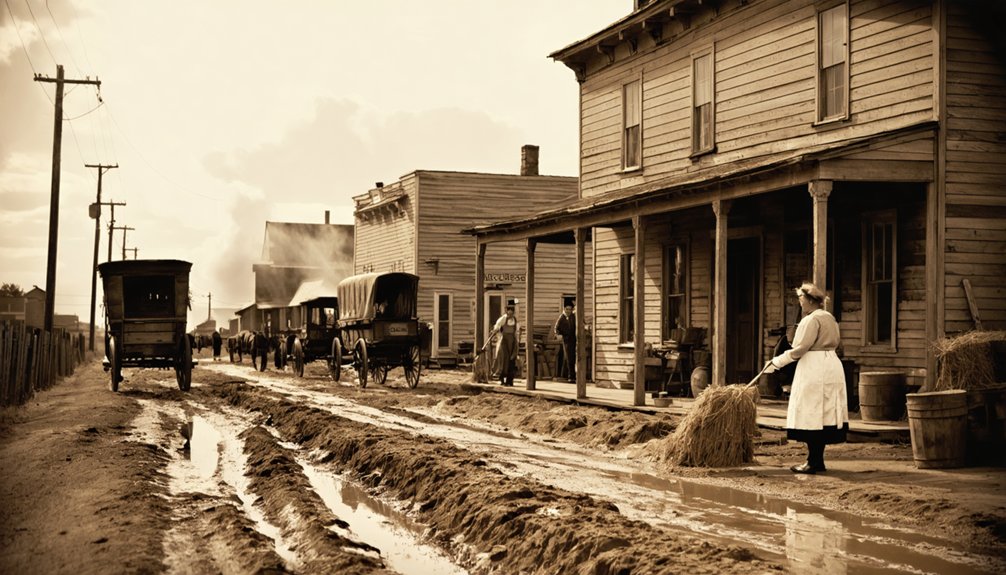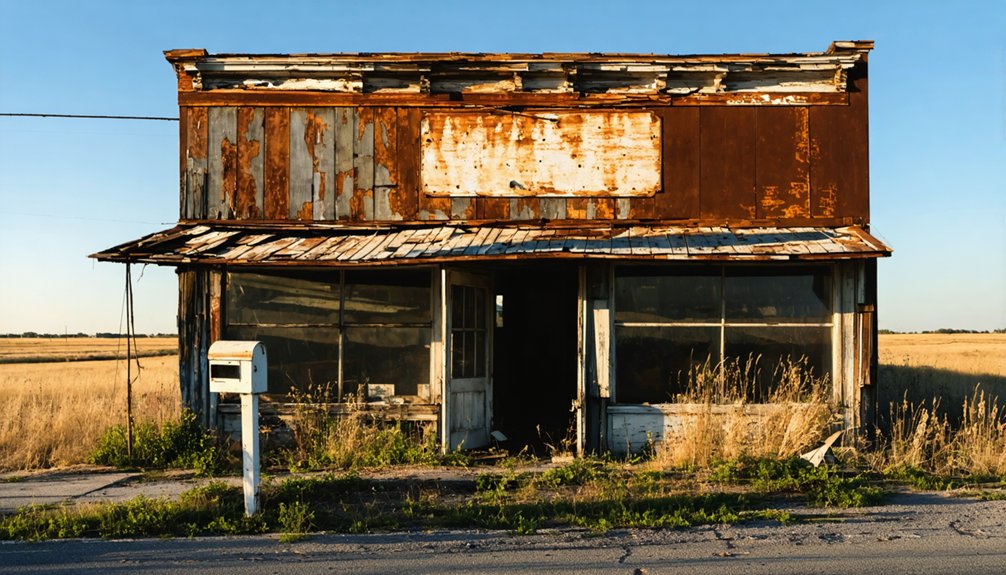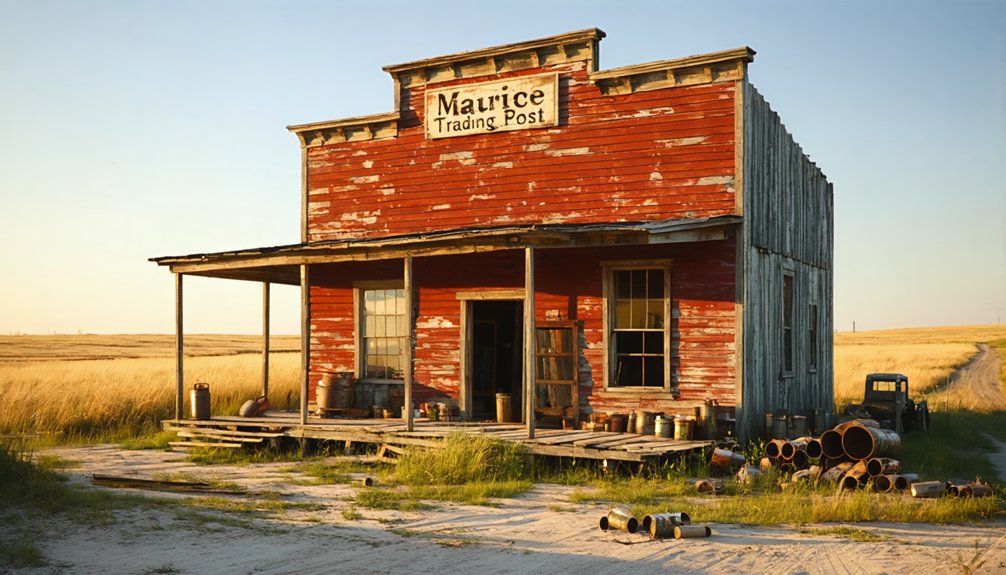You’ll find Maurice nestled in Brown County, South Dakota, where it emerged as a bustling railroad town in 1886. The Minneapolis & St. Louis Railroad transformed this settlement into a crucial agricultural hub, with its population peaking at 136 residents. Today, only the Carbonate Cemetery and scattered ruins remain to tell tales of the town’s prosperous past. While drought, prairie fires, and the railroad’s closure sealed Maurice’s fate, its compelling story of boom-and-bust still echoes across the Dakota prairie.
Key Takeaways
- Maurice was established in 1886 in Brown County, South Dakota, reaching a peak population of 136 residents before becoming a ghost town.
- The Minneapolis & St. Louis Railroad’s arrival in 1907 transformed Maurice into a thriving agricultural hub and freight transportation center.
- Severe droughts, crop failures, and the closure of the Chicago Milwaukee Railroad led to the town’s eventual abandonment.
- The community relied heavily on agriculture and railroad connections, with its layout specifically designed to optimize cargo operations.
- Today, few physical traces remain of Maurice except for the Carbonate Cemetery, which serves as a memorial to early settlers.
Historical Origins and Settlement
As settlers pushed westward across the Great Plains in the late 19th century, the small town of Maurice emerged in Brown County, South Dakota. In 1886, pioneering families established this frontier community, naming it after the French city of Verdun.
The town’s settlement patterns reflected the robust agricultural practices of the era, with farmers drawn to the flat, fertile landscape ideal for grain production. Like many other communities that became ghost towns, Maurice experienced dramatic changes in population and economic activity over time. The region’s development paralleled that of mining towns like Mystic, where the establishment of a post office in 1885 marked a significant milestone in community growth.
Early settlers found their calling in Maurice’s fertile plains, where rich soil promised abundant harvests and agricultural prosperity.
You’ll find that Maurice’s early development mirrored many northern Plains communities, where European immigrants sought their slice of freedom through farming. The town grew steadily until it reached about 136 residents at its peak, establishing itself as a modest but essential agricultural hub.
A network of industrious families built the fundamental frameworks of community life, including local businesses and social institutions that would serve their needs.
Railroad’s Role in Maurice’s Development
When the Minneapolis & St. Louis Railroad pushed westward to the Missouri River in 1907, you’d have found Maurice strategically positioned along its path, becoming one of many new towns springing up to serve the rail line’s expansion.
You would’ve seen Maurice quickly develop into a bustling freight transportation hub, with local farmers and merchants relying on the railroad to ship their grain and livestock to distant markets. Local speculators invested heavily in Maurice’s surrounding land, anticipating significant returns from the railroad’s presence. Like many South Dakota communities, Maurice’s streets followed a classic T-shape layout with the commercial avenue running perpendicular to the tracks.
The eventual closure of Maurice’s station would prove devastating to the town’s economy, as the crucial rail connection that once breathed life into the community disappeared, taking with it the town’s primary economic lifeline.
Rail Line Construction Impact
The Minneapolis & St. Louis railroad’s westward expansion in 1906-1907 fundamentally shaped Maurice’s identity, as you’d find in many South Dakota settlements where railroad influence determined a town’s destiny.
The promise of reliable transportation and market access through the new rail line sparked rapid development, transforming Maurice from open prairie to a bustling community.
- You’d have witnessed the town’s strategic positioning along the rail route, where speculators and railroad insiders carefully planned its layout to maximize commercial potential.
- Within weeks of the rail line’s arrival, essential infrastructure emerged – grain elevators, stockyards, and merchant establishments.
- The railroad’s presence guaranteed year-round access to crucial supplies and created reliable shipping routes for local farmers’ grain and livestock.
Freight Transportation Hub Development
Through Maurice’s strategic position on the Minneapolis & St. Louis Railway line, you’ll find a proof of freight efficiency that shaped this once-bustling hub.
By the early 1900s, the railroad company transformed Maurice into an essential livestock infrastructure center, complete with stockyards and handling facilities that streamlined animal transport.
You would’ve witnessed countless farmers and ranchers converging on Maurice, drawn by its seamless rail connections and reasonable freight rates.
The town’s layout, carefully orchestrated by railroad surveyors, maximized cargo operations while linking eastern rail systems to western South Dakota routes.
This prime location near the Missouri River created the perfect storm for agricultural prosperity, as local farmers could now ship their grain year-round to distant markets.
Maurice’s rail-driven economy flourished, creating a robust network of warehouses and freight-handling enterprises.
Station Closure Economic Effects
Following Maurice’s rail station closure in the mid-twentieth century, you’d have witnessed a devastating economic chain reaction that forever altered the town’s destiny. Without rail access, Maurice’s economic resilience crumbled as businesses lost their competitive edge and freight costs skyrocketed. The community’s attempts at adaptation proved insufficient against the overwhelming challenges.
The ripple effects devastated the town’s infrastructure and social fabric:
- Local grain elevators and merchants shuttered their doors, unable to compete with rail-connected towns like Mitchell and Murdo.
- Property values plummeted while families migrated away, seeking opportunities elsewhere.
- Essential services vanished one by one – schools closed, the post office shut down, and maintenance of roads and utilities declined.
These changes transformed Maurice from a bustling railroad hub into a shadow of its former self.
Economic Rise and Decline
While many Black Hills settlements rose and fell with mining fortunes, Maurice’s economic trajectory painted a more complex picture of boom-and-bust cycles.
You’ll find that early mining ventures, though promising, struggled with transportation limitations and mill mismanagement, leading to a steady mining decline. The town’s resilience showed when it embraced a timber shift, with the Frink sawmill becoming its economic backbone in 1918. The sawmill operations remained vital until George Frink’s exit in 1952.
The railroad’s arrival in 1889 initially fueled growth, but you’d see dramatic changes as transportation evolved. Much like Deadwood’s casino revival in 1989, the town sought new economic opportunities to survive.
When automobiles arrived in the 1920s, tourism offered brief hope. Yet despite these adaptations, the town couldn’t overcome mounting challenges.
The Crouch Line’s closure in 1947, resource depletion, and environmental setbacks gradually eroded Maurice’s economic foundation until its eventual abandonment.
Daily Life in Early Maurice

As settlers carved out their lives in early Maurice, you’d find a close-knit community shaped by Scandinavian immigrant values and agricultural practices. Your days would revolve around farming duties, tending to wheat fields and livestock, while maintaining strong bonds through community gatherings at the local church and schoolhouse. Like many early South Dakota settlements, Maurice faced extreme temperatures and required considerable resilience from its inhabitants. The local general store served as a vital hub where settlers could trade their harvested goods for essential supplies, much like the trading posts that dotted the region in the 1830s.
Living in Maurice meant embracing a self-sufficient lifestyle where you’d:
- Grow your own food in home gardens and preserve it through canning and smoking
- Share labor during critical times like barn raisings and harvests
- Gather for social events like barn dances and church socials to maintain cultural traditions
Simple frame houses and outhouses marked the landscape, while wood stoves kept you warm through harsh Dakota winters.
You’d find comfort in traditional Scandinavian dishes and the support of neighbors who’d become like family.
Natural Disasters and Challenges
You’d hardly recognize Maurice’s once-prosperous fields during the devastating droughts of the early 1900s, when crop failures left families struggling to survive on what little they could salvage.
Prairie fires would sweep across the landscape with frightening speed, destroying not just crops but also threatening homes and livestock that stood in their path.
The brutal winter storms would often leave Maurice completely cut off from neighboring communities for weeks at a time, testing the resilience of those who remained.
Much like many ghost town sites across South Dakota, the abandoned buildings slowly deteriorated and returned to empty fields.
Like many South Dakota towns, Maurice’s fate was sealed when the Chicago Milwaukee Railroad abandoned its operations in the region.
Drought and Crop Failures
When prolonged drought periods struck Maurice in the early 20th century, the town’s agricultural foundation began to crumble.
You’d have witnessed the devastating drought impacts as farmers struggled with diminishing water supplies and deteriorating soil conditions. The once-rich prairie lands couldn’t retain enough moisture to sustain crops, leading to catastrophic crop failures that shattered the local economy.
- Farmers were forced to abandon irrigation systems, watching helplessly as their fields withered.
- Failed harvests made it impossible for families to repay mounting debts.
- Natural water scarcity combined with outdated farming practices intensified the agricultural crisis.
The harsh reality of these conditions drove many residents to seek opportunities elsewhere, leaving behind their dreams of prosperous farmland and ultimately contributing to Maurice’s transformation into a ghost town.
Devastating Prairie Fires
Prairie fires swept through Maurice with merciless intensity during the town’s most vulnerable years, threatening both life and property across the windswept plains.
You’ll find that these natural infernos, sparked by lightning strikes or human activity, posed a particularly formidable challenge for the isolated community. With limited access to firefighting resources and vast expanses of dry prairie grass, fire prevention became a constant struggle for Maurice’s residents.
The town’s community resilience was tested as farmers and ranchers faced the devastating loss of crops, livestock, and grazing lands. Strong winds could transform a small spark into an unstoppable force within minutes, leaving little time for residents to protect their homesteads.
While specific records of Maurice’s battles with prairie fires are scarce, these natural disasters likely contributed to the town’s eventual decline.
Winter Storm Isolation
Beyond the threat of prairie fires, Maurice’s residents faced an even more formidable challenge in the brutal winter storms that regularly cut off the town from the outside world.
You’d have found winter survival particularly demanding when blizzards swept across the prairie, bringing dangerous whiteout conditions and snowdrifts several feet high. Storm preparation became second nature as residents learned from the harsh lessons of pioneers who’d endured isolation during historic winters like 1880-1881.
- Communities stockpiled supplies and rationed food when railroad lines became blocked, sometimes for months.
- Families sought refuge in public shelters when temperatures plummeted and winds reached 70 mph.
- Livestock struggled against freezing rain and hypothermia, often breaking fences to huddle near buildings for protection.
Those who called Maurice home knew their survival depended on resilience and mutual aid during these devastating winter sieges.
Notable Buildings and Landmarks
Maurice boasted several distinctive buildings and landmarks during its brief but vibrant existence as a frontier town.
You’d have found two historic hotels anchoring the community, with the Kappa Hotel drawing visitors seeking mineral bath treatments. A Methodist and Catholic church served the spiritual needs of residents, while a bustling community hall hosted local gatherings and events.
The town’s commercial district included a bank and various shops, reflecting its role as a service hub. A newspaper office and schoolhouse demonstrated the community’s commitment to civic life and education.
Public bathhouses capitalized on the valley’s mineral springs, making Maurice a destination for health-seeking travelers.
Today, these abandoned structures stand as silent witnesses to the town’s fleeting prosperity, their weathered remains telling stories of a once-thriving frontier community.
The Final Years of Population

While many South Dakota towns faced gradual decline in the mid-20th century, the depopulation of Maurice proved particularly swift and decisive. The ghost town demographics shifted dramatically as mechanized farming and economic pressures forced younger residents to seek opportunities elsewhere, leaving behind an increasingly aging population.
- Agricultural consolidation reduced local job prospects, causing families to relocate to larger cities.
- Essential services vanished one by one – schools closed, stores shuttered, and medical facilities moved away.
- Aging residents became the last holdouts, maintaining their properties until declining health or lack of services made staying impossible.
You’ll find Maurice’s story echoed across rural South Dakota, where 38 of 66 counties experienced similar population losses, transforming once-vibrant communities into memories of a bygone era.
Present-Day Site Conditions
Today, visitors searching for remnants of Maurice’s past will find few tangible traces of the once-thriving community, save for the enduring Carbonate Cemetery that marks the area’s mining heritage.
The cemetery stands as a poignant reminder of the harsh realities faced by early settlers, with numerous graves belonging to children who didn’t survive the demanding conditions of frontier life.
While cemetery preservation efforts have maintained the grounds to some degree, you’ll find limited infrastructure supporting visitor accessibility.
There aren’t any interpretive panels or formal tours to guide your exploration. The remote location and minimal signage mean you’ll need determination to discover this hidden piece of South Dakota’s mining history.
Natural weathering continues to shape the landscape, slowly erasing what remains of Maurice’s story.
Preserving Maurice’s Legacy

Despite the site’s current state of decay, dedicated efforts to preserve Maurice’s legacy continue through various state and community initiatives.
Even as Maurice slowly fades, a committed network of state and local groups works tirelessly to protect its historical significance.
Through the South Dakota State Historic Preservation Office’s guidance, you’ll find preservation strategies that blend documentation, community engagement, and historical education to keep Maurice’s story alive for future generations.
Key preservation efforts include:
- Local historical societies maintaining detailed records and photographs of Maurice’s past
- Community volunteers participating in site maintenance and cleanup projects
- Educational programs that bring students to explore Maurice’s archaeological significance
You’re invited to join these preservation efforts, whether through volunteering, attending educational workshops, or supporting local initiatives.
Your involvement helps guarantee that Maurice’s unique place in South Dakota’s history won’t be forgotten, even as time marches forward.
Frequently Asked Questions
Were Any Notable Crimes or Lawless Incidents Recorded in Maurice’s History?
You won’t find any documented crime incidents or law enforcement records from Maurice’s past. Historical sources haven’t preserved accounts of lawlessness, unlike other ghost towns that sometimes retain tales of frontier disorder.
What Native American Tribes Originally Inhabited the Maurice Area?
While the Dakota Sioux were prominent in the region, you’ll find that earlier peoples left traces of their Lakota culture and tribal heritage dating back 10,000 years as hunter-gatherers.
Did Maurice Have Any Unique Local Traditions or Annual Celebrations?
You won’t find records of local festivals or cultural heritage events from Maurice – among the 80+ documented ghost towns in South Dakota, it’s one of many whose community traditions have vanished without a trace.
What Was the Peak Population of Maurice During Its Most Prosperous Period?
You won’t find exact population trends for this elusive settlement’s peak, but like many prairie towns that faced economic decline, it’s believed to have followed the typical pattern of small homesteading communities.
Were There Any Documented Paranormal Stories Associated With Maurice’s Abandoned Sites?
You won’t find any ghost sightings or haunted locations here – despite South Dakota’s rich paranormal history, there aren’t any documented supernatural stories associated with Maurice’s abandoned industrial remains.
References
- https://www.sdpb.org/rural-life-and-history/2023-08-21/some-black-hills-ghost-towns-and-their-origins
- https://www.legendsofamerica.com/sd-okaton/
- https://www.legendsofamerica.com/mystic-south-dakota/
- https://www.youtube.com/watch?v=M-RQlR05dt4
- https://ghostsofnorthdakota892857007.wordpress.com/2015/10/30/true-ghost-towns-population-zero/
- https://en.wikipedia.org/wiki/List_of_ghost_towns_in_South_Dakota
- https://b1027.com/south-dakota-has-an-abundance-of-ghost-towns/
- https://www.youtube.com/watch?v=PgjxhfJ9yhQ
- https://www.1880town.com
- https://www.sdhspress.com/journal/south-dakota-history-2-2/some-black-hills-ghost-towns-and-their-origins/vol-02-no-2-some-black-hills-ghost-towns-and-their-origins.pdf



